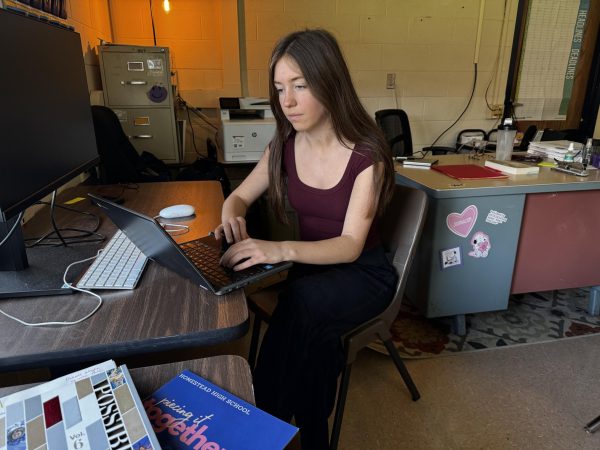Second local high school hosts vaping awareness event
Dr. Charlene Gaebler-Uhling (left) and Sue Martin (right) answer parents’ questions at the end of the presentation.
To raise awareness, the Ozaukee County area is highlighting just how dangerous the trend of vaping, or more commonly known as “juuling,” is to parents and teens.
The Mequon-Thiensville School District held a vaping summit on March 15, 2019 at Homestead. The Cedarburg School District felt it was important to do the same and hold a vaping summit at Cedarburg High School on Tuesday, October 22. Since Homestead’s event 7 months ago, e-cigarette users in the United States have faced catastrophic health issues.
Dr. Charlene Gaebler-Uhing and Dr. Louella Amos, both from Children’s Hospital of Wisconsin, attended the event on Tuesday night to speak to parents and teens about illnesses that have rapidly arisen from vaping, symptoms to look for if they suspect their teens are using e-cigarettes, and ways parents can ultimately help their children quit.
Popular e-cigarette devices like JUULs, sourins, novos, are just three examples of the hundreds of choices that teens can choose from to deliver their vaping desires. According to Dr. Gaebler, these devices are attractive because they’re easy to conceal. “Teens are drawn to these devices because they are not hard to hide. Adults often think a juul looks like a flash drive, making it easy for kids to sneak into class. Most vape devices are small and easily fit into pockets. They also leave behind no trace of scent, unlike traditional cigarettes,” Dr. Gaebler said.
Dr. Gaebler stated nicotine use starts primarily at adolescent ages. “The battling ground is in the teen years, because 90% of lifetime users have started by the age of 18,” Dr. Gaebler said. She proceeded to explain how teens are attracted by advertisements of flavors from of e-cigarette companies, including mango, mint, fruit punch, cotton candy and hundreds of others.
Dr. Gaebler emphasized that quitting can be so difficult for teens because with frequent use, they develop a dependency on the nicotine. “Because their brains are so susceptible, teens have become dependent on less than 100 cigarettes, which is equal to just 5 JUUL pods. They don’t even have to be daily users to be addicted, they can become addicted if they’re occasional users. Luckily with the recent outbreak of lung injuries, this is a big motivator for some to quit,” Dr. Gaebeler said.
Following Dr. Gaebler’s presentation, Dr. Louella Amos took the stage to provide her viewpoints and findings from working directly with patients at Children’s Hospital affected by these lung illnesses. Dr. Amos has a special interest in both pulmonary and sleep expertise as such as sleep-disordered breathing and anatomic airway abnormalities. “As of October 15, there are about 1500 lung illness cases related to vaping [in the United States] and 33 deaths that have been confirmed. 75% of these patients are under 35 years of age and 15% are under age 18,” Amos said.
“The most common symptoms we’ve seen in these patients at Children’s Hospital have been fatigue, fevers, night sweats, abdominal pain, nausea, vomiting, weight loss as significant as 40 pounds, chest pain, coughing, and shortness of breath,”Amos said. Speaking scientifically, Amos explained to parents that “what’s happening in these teen’s lungs is an inflammatory reaction and the lungs are trying to defend itself.”
According to an article “A parent’s guide to vaping,” published by Michael O. Schroeder on US.news.com, key things for parents to do to help support their kids is “talk to your kids about the risks, familiarize yourself with the products, and ultimately help your child quit, whether they quit cold turkey or wean off, but it’s critical they receive parental support as well as professional help if needed,” Schroeder said.
He closed by stating “clinicians say the bottom line is to support your child to quit now, before harms accumulate or a child moves on to traditional cigarettes and is exposed to even more serious, well-known dangers.”

Annie McCormick is a Senior at Homestead High School. She ran cross country her first two years of high school and then switched to becoming more involved...










